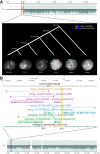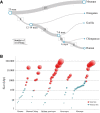Single-cell strand sequencing of a macaque genome reveals multiple nested inversions and breakpoint reuse during primate evolution
- PMID: 33093070
- PMCID: PMC7605249
- DOI: 10.1101/gr.265322.120
Single-cell strand sequencing of a macaque genome reveals multiple nested inversions and breakpoint reuse during primate evolution
Abstract
Rhesus macaque is an Old World monkey that shared a common ancestor with human ∼25 Myr ago and is an important animal model for human disease studies. A deep understanding of its genetics is therefore required for both biomedical and evolutionary studies. Among structural variants, inversions represent a driving force in speciation and play an important role in disease predisposition. Here we generated a genome-wide map of inversions between human and macaque, combining single-cell strand sequencing with cytogenetics. We identified 375 total inversions between 859 bp and 92 Mbp, increasing by eightfold the number of previously reported inversions. Among these, 19 inversions flanked by segmental duplications overlap with recurrent copy number variants associated with neurocognitive disorders. Evolutionary analyses show that in 17 out of 19 cases, the Hominidae orientation of these disease-associated regions is always derived. This suggests that duplicated sequences likely played a fundamental role in generating inversions in humans and great apes, creating architectures that nowadays predispose these regions to disease-associated genetic instability. Finally, we identified 861 genes mapping at 156 inversions breakpoints, with some showing evidence of differential expression in human and macaque cell lines, thus highlighting candidates that might have contributed to the evolution of species-specific features. This study depicts the most accurate fine-scale map of inversions between human and macaque using a two-pronged integrative approach, such as single-cell strand sequencing and cytogenetics, and represents a valuable resource toward understanding of the biology and evolution of primate species.
© 2020 Maggiolini et al.; Published by Cold Spring Harbor Laboratory Press.
Figures




Similar articles
-
Unraveling the effect of genomic structural changes in the rhesus macaque - implications for the adaptive role of inversions.BMC Genomics. 2014 Jun 26;15(1):530. doi: 10.1186/1471-2164-15-530. BMC Genomics. 2014. PMID: 24969235 Free PMC article.
-
Inversion variants in human and primate genomes.Genome Res. 2018 Jun;28(6):910-920. doi: 10.1101/gr.234831.118. Epub 2018 May 18. Genome Res. 2018. PMID: 29776991 Free PMC article.
-
Fine-Mapping Complex Inversion Breakpoints and Investigating Somatic Pairing in the Anopheles gambiae Species Complex Using Proximity-Ligation Sequencing.Genetics. 2019 Dec;213(4):1495-1511. doi: 10.1534/genetics.119.302385. Epub 2019 Oct 30. Genetics. 2019. PMID: 31666292 Free PMC article.
-
Inversions on human chromosomes.Am J Med Genet A. 2023 Mar;191(3):672-683. doi: 10.1002/ajmg.a.63063. Epub 2022 Dec 10. Am J Med Genet A. 2023. PMID: 36495134 Review.
-
Human inversions and their functional consequences.Brief Funct Genomics. 2015 Sep;14(5):369-79. doi: 10.1093/bfgp/elv020. Epub 2015 May 20. Brief Funct Genomics. 2015. PMID: 25998059 Free PMC article. Review.
Cited by
-
Complete sequencing of ape genomes.bioRxiv [Preprint]. 2024 Oct 5:2024.07.31.605654. doi: 10.1101/2024.07.31.605654. bioRxiv. 2024. Update in: Nature. 2025 May;641(8062):401-418. doi: 10.1038/s41586-025-08816-3. PMID: 39131277 Free PMC article. Updated. Preprint.
-
Adaptive functions of structural variants in human brain development.Sci Adv. 2024 Apr 5;10(14):eadl4600. doi: 10.1126/sciadv.adl4600. Epub 2024 Apr 5. Sci Adv. 2024. PMID: 38579006 Free PMC article.
-
Genomic structural variation: A complex but important driver of human evolution.Am J Biol Anthropol. 2023 Aug;181 Suppl 76(Suppl 76):118-144. doi: 10.1002/ajpa.24713. Epub 2023 Feb 16. Am J Biol Anthropol. 2023. PMID: 36794631 Free PMC article. Review.
-
A high-resolution map of small-scale inversions in the gibbon genome.Genome Res. 2022 Oct;32(10):1941-1951. doi: 10.1101/gr.276960.122. Epub 2022 Sep 30. Genome Res. 2022. PMID: 36180231 Free PMC article.
-
Complete sequencing of ape genomes.Nature. 2025 May;641(8062):401-418. doi: 10.1038/s41586-025-08816-3. Epub 2025 Apr 9. Nature. 2025. PMID: 40205052 Free PMC article.
References
Publication types
MeSH terms
Grants and funding
LinkOut - more resources
Full Text Sources
Miscellaneous
